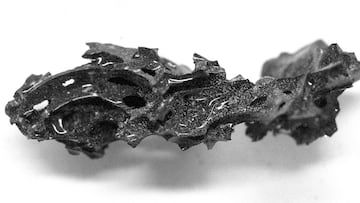Scientists discover obsidian from Vesuvius in the brain of a man turning part of it into glass: “it is the only case of its kind on Earth”
Scientists have made the shocking discovery that the man’s brain had indeed turned into glass.


The volcanic eruption of Vesuvius in 79 AD that buried the Italian city of Pompeii, with its inhabitants suffering a deadly fate, is a piece of history etched into the minds of many. A seemingly farfetched yet very real story, it highlights the power of the planet we live on and still captures the imagination of millions of people today.
But not many know that an even crazier story happened in the village of Herculaneum, just a few miles away.
Scientists have discovered a man whose brain was quite literally turned to glass by the sheer heat of the volcanic eruption.
Those investigation the remains of the man, first discovered in the 1960s, found dark substances inside the brain cavity that resembled obsidian, before working out that a process of vitrification - turning something into glass - had taken place.
The brain of a man who died nearly 2000 years ago was turned to glass by extreme conditions during the eruption of Mount Vesuvius pic.twitter.com/t3tC9rQ9g8
— nature (@Nature) February 27, 2025
Glass brain like ‘no other case in the world’
They say the victim’s brain was the apparent effect of a scorching ash cloud that descended across the Bay of Naples, and concluded that the process of turning his grey matter into glass happened due to a rapid exposure of the brain’s organic material to a very high temperature - at least 510 degrees Celsius (950°F) - and its subsequent rapid cooling.
Pier Paolo Petrone of Università di Napoli Federico II was one of the leaders of the research published in the journal Scientific Reports. He said that “the glass formed as a result of this process allowed for an integral preservation of the biological brain material and its microstructures.”
“The only other type of organic glass we have evidence of is that produced in some rare cases of vitrification of wood, sporadic cases of which have been found at Herculaneum and Pompeii. However, in no other case in the world have vitrified organic human or animal remains ever been found,” Petrone added.
Researchers believe this man’s brain turned to glass — and the reason might have something to do with a volcanic eruption at Mt. Vesuvius 2,000 years ago 🧠 pic.twitter.com/VHOxsT2EuY
— NowThis Impact (@nowthisimpact) January 28, 2020
“Taking one of these fragments, it had a black appearance and shiny surfaces quite similar to obsidian, a natural glass of volcanic origin - black and shiny, whose formation is due to the very rapid cooling of the lava. But, unlike obsidian, the glassy remains were extremely brittle and easy to crumble,” Petrone concluded.
Get your game on! Whether you’re into NFL touchdowns, NBA buzzer-beaters, world-class soccer goals, or MLB home runs, our app has it all. Dive into live coverage, expert insights, breaking news, exclusive videos, and more – plus, stay updated on the latest in current affairs and entertainment. Download now for all-access coverage, right at your fingertips – anytime, anywhere.


Complete your personal details to comment
Your opinion will be published with first and last names